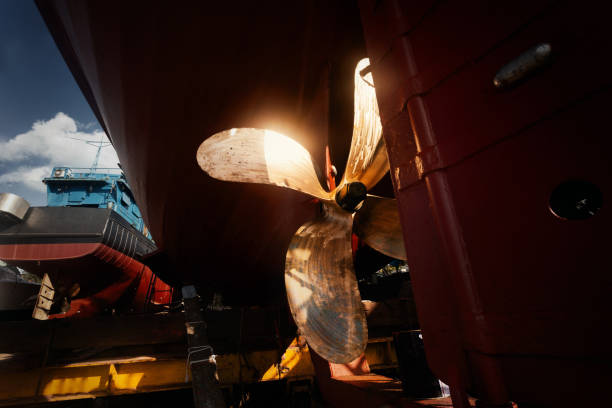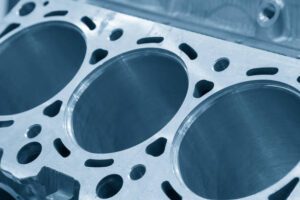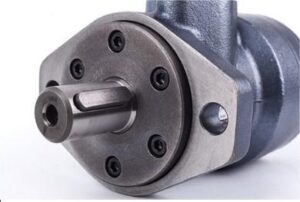
What is ship propeller meaning
A boat propeller composed of a hub (a round hole for inserting the shaft) and a number of blades that are radially fixed on the hub is commonly known as a blade. The Marine propeller is installed below the stern waterline, and is powered by the main engine (see ship power plant) to rotate, push water towards the ship, and use the water’s reaction force to push the ship forward. Gosea Marine’s Boat propeller is simple, lightweight, efficient and protected below the waterline.
Types of Marine Propeller
The propeller is the main propulsion tool of modern ships, and most ships are now propelled by propeller. There are many types of boat propellers.
1.Depending on the number of blades:
Marine propeller has 2, 3 or 4 blades, or even more. Generally, the greater the number of blades, the greater the absorption power.
2. According to the different structure:
The ship propeller is divided into fixed (paddle) pitch and variable pitch propeller 2 categories.
Fixed pitch propeller for boats:
It is fixed and constant. It is characterized by simple structure and light weight, so it is widely used in ships.
Controllable Pitch Propeller:
The pitch can be adjusted, through the propeller pitch mechanism, Marine hydraulic system or electric drive to adjust the pitch. Two-pitch propellers were originally used. At high speed, high pitch is used, at low speed, low pitch is used, and then the number of pitch is gradually increased.

Choose Best Propeller for My Boat
Ordinary transport ships have 1 or 2 propellers. Ships with large propulsion power can increase the number of propellers.
Large express passenger ships have double to four OARS. The ship propeller generally has 3 to 4 blades, the diameter of which is determined according to the ship’s horsepower and draft. The bottom end does not touch the bottom, and the top end does not exceed the full load line.
The ship propeller speed should not be too high, the ocean cargo ship is about 100 revolutions per minute, and the small speed boat is as high as 400 to 500 revolutions per minute, but the efficiency will be affected.
Marine Propeller Materials are generally manganese bronze or corrosion resistant alloy, but also stainless steel boat propeller, nickel-aluminum bronze or cast iron.
Since the 1960s, ships tend to be large-scale. After the use of high-power main engine, ship propeller induced stern vibration, structural damage, noise, erosion and other problems caused by the attention of countries. The fundamental reason of propeller excitation is that the Marine propeller blade load is increased, and it is easy to produce local unstable cavitation when working in the uneven wake of the ship, which causes the pressure, amplitude and phase of the propeller acting on the ship to change constantly.
On the basis of ordinary ship propellers, in order to improve performance, better adapt to various navigation conditions and make full use of the main engine power, the following special marine propellers have been developed.
Controllable Pitch Ship Propeller
Referred to as Variable pitch propeller, can adjust the pitch as needed to give full play to the power of the main engine; Improve propulsion efficiency, without changing the direction of main engine rotation when the ship is retrograde. Pitch is adjusted by mechanically or hydraulically operating a mechanism in the hub to turn each blade. Pitch paddle has good adaptability to blade load change, and it is widely used in tugboats and fishing boats. For general transport ships, ship-machine-oars can be in a good matching state.
However, the hub diameter of the Controllable pitch propeller is much larger than that of the ordinary ship propeller, and the section of the blade root is thick and narrow. Under normal operating conditions, its efficiency is lower than that of the ordinary propeller, and it is expensive and complex to maintain.
Ducted Ship Propeller for Sale:
 A circular duct with an airfoil section is installed on the outer edge of the ordinary propeller. This catheter is also called the Koch catheter. The conduit is called a fixed conduit, and the conduit is connected to the rotating rudder rod and is called a rotating conduit that acts as a rudder blade. The conduit can improve the propeller propulsion efficiency, because the flow rate inside the conduit is high, the pressure is low, and the pressure difference inside and outside the conduit forms additional thrust on the tube wall.
A circular duct with an airfoil section is installed on the outer edge of the ordinary propeller. This catheter is also called the Koch catheter. The conduit is called a fixed conduit, and the conduit is connected to the rotating rudder rod and is called a rotating conduit that acts as a rudder blade. The conduit can improve the propeller propulsion efficiency, because the flow rate inside the conduit is high, the pressure is low, and the pressure difference inside and outside the conduit forms additional thrust on the tube wall.
The clearance between the conduit and the propeller blade is very small, which limits the flow loss around the blade tip. The duct can reduce the wake contraction behind the boat propeller, so that the energy loss is reduced. But the reversing performance of ducted propeller is poor. The fixed ducted propeller can increase the ship’s rotating diameter, and the rotating ducted propeller can improve the ship’s rotating performance. Ducted propellers are often used to push ships.
Coaxial Ship Propeller
It is a design form of a ship’s propulsion system consisting of two or more propellers, one of which is positioned above or below the other and rotating in the opposite direction. Compared with the traditional single propeller, Marine tandem propeller has some advantages.

- 1.Marine Coaxial propellers provide greater thrust efficiency. Since the two propellers rotate in opposite directions, the spins they produce cancel each other out, reducing the spin loss and thus improving the propulsion efficiency.
- 2.Marine Coaxial propellers have smaller ship vibration and noise levels. By balancing the rotation directions of the two propellers against each other, vibration and noise can be reduced, providing a smoother and more comfortable sailing experience.
- 3.Marine Coaxialpropellers also have flexible handling performance. Because the position and direction of rotation of the propeller can be independently controlled, the ship can achieve better maneuverability and maneuverability, including operations such as side pushing, rotating and berthing.
Fixed Pitch Marine Propeller

It consists of 4 to 8 vertical paddles. Fixed-Pitch propeller upper disc-shaped, paddle blade along the circumference of the disc uniformly installed. The bottom of the disc and the hull plate flush with each other, when the disc rotates, in addition to the blade around the spindle rotation.
It also around its own vertical axis swing, thus generating a different direction of the thrust. Then the ship can be made to rotate in place, do not have to use the rudder to steer the ship backward or change the main engine steering. However, due to the complexity of the mechanism, expensive, easy to damage the blade, only for a small number of harbor ships or special requirements for the maneuvering performance of the ship.






